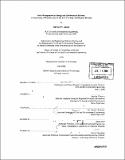Data management in energy and environment systems : a case study of Web services in the E.P.A.'s Clean Air Markets Division.
Author(s)
Adams, Michael W. (Michael Wayne), 1978-
DownloadFull printable version (3.893Mb)
Other Contributors
Massachusetts Institute of Technology. Dept. of Civil and Environmental Engineering.
Advisor
Stephen Connors and John R. Williams.
Terms of use
Metadata
Show full item recordAbstract
The components comprising the energy and environment system for electric power are both complex and data intensive. With monitoring of different system components becoming common, increasingly the limits posed on participants in the energy and environment system, from federal and state governments to policy analysts, is not the lack of reliably measured data, but the inaccessibility and poor usability of the data that is available. These factors are complicated by the nature of the system that is constantly changing and which holds a diverse and sometimes competing group of stakeholders. This thesis makes the case for smart data management and application integration using XML and Web services technologies for government agencies involved in the energy and environment system. The features of a service-oriented IT architecture (simple, robust, heterogeneous, distributed) are elements lacking from the current system of data acquisition and dissemination. The U.S. Environmental Protection Agency's Clean Air Markets Division is taken as a case study. The division is charged with managing the IT system for determining compliance with the Acid Rain and NOx Budget Trading programs. The system requires managing data collection from numerous and ever-changing electric generating units, storing data, determining compliance with environmental regulations, and disclosing the data to a heterogeneous set of users. The transition to a service-oriented architecture based on web services and XML is seen to have small capital costs to the agency, while significantly reducing the transaction costs various users have for accessing the data. A change of technology both enhances performance of the current system and opens up a realm of possibilities for the future. (cont.) As an organization, the EPA has a multitude of resources to rely on as they transition the IT infrastructure to a more accessible and usable state. This transition will begin to enable real, tangible feedback between components of the energy and environment system.
Description
Thesis (S.M.)--Massachusetts Institute of Technology, Engineering Systems Division, Technology and Policy Program; and, (S.M.)--Massachusetts Institute of Technology, Dept. of Civil and Environmental Engineering, 2004. Includes bibliographical references (p. 70-72).
Date issued
2004Department
Massachusetts Institute of Technology. Department of Civil and Environmental Engineering; Massachusetts Institute of Technology. Engineering Systems Division; Technology and Policy ProgramPublisher
Massachusetts Institute of Technology
Keywords
Technology and Policy Program., Civil and Environmental Engineering.